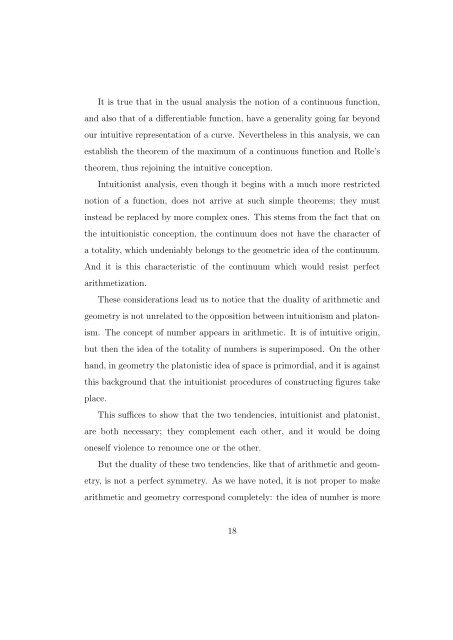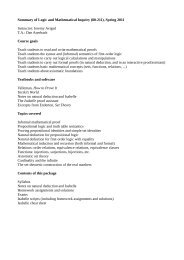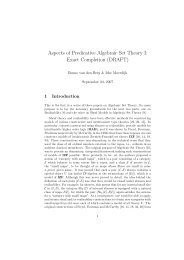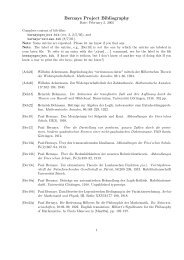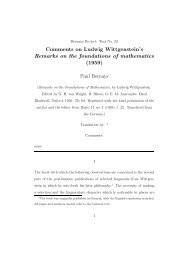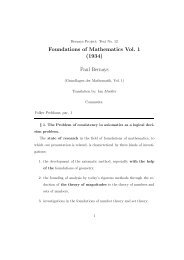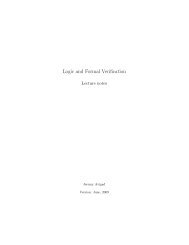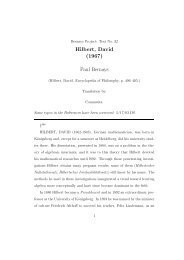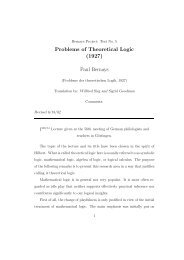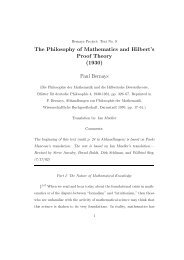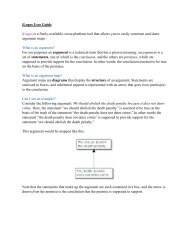Platonism in mathematics (1935) Paul Bernays - Phil Cmu
Platonism in mathematics (1935) Paul Bernays - Phil Cmu
Platonism in mathematics (1935) Paul Bernays - Phil Cmu
Create successful ePaper yourself
Turn your PDF publications into a flip-book with our unique Google optimized e-Paper software.
It is true that <strong>in</strong> the usual analysis the notion of a cont<strong>in</strong>uous function,<br />
and also that of a differentiable function, have a generality go<strong>in</strong>g far beyond<br />
our <strong>in</strong>tuitive representation of a curve. Nevertheless <strong>in</strong> this analysis, we can<br />
establish the theorem of the maximum of a cont<strong>in</strong>uous function and Rolle’s<br />
theorem, thus rejo<strong>in</strong><strong>in</strong>g the <strong>in</strong>tuitive conception.<br />
Intuitionist analysis, even though it beg<strong>in</strong>s with a much more restricted<br />
notion of a function, does not arrive at such simple theorems; they must<br />
<strong>in</strong>stead be replaced by more complex ones. This stems from the fact that on<br />
the <strong>in</strong>tuitionistic conception, the cont<strong>in</strong>uum does not have the character of<br />
a totality, which undeniably belongs to the geometric idea of the cont<strong>in</strong>uum.<br />
And it is this characteristic of the cont<strong>in</strong>uum which would resist perfect<br />
arithmetization.<br />
These considerations lead us to notice that the duality of arithmetic and<br />
geometry is not unrelated to the opposition between <strong>in</strong>tuitionism and platon-<br />
ism. The concept of number appears <strong>in</strong> arithmetic. It is of <strong>in</strong>tuitive orig<strong>in</strong>,<br />
but then the idea of the totality of numbers is superimposed. On the other<br />
hand, <strong>in</strong> geometry the platonistic idea of space is primordial, and it is aga<strong>in</strong>st<br />
this background that the <strong>in</strong>tuitionist procedures of construct<strong>in</strong>g figures take<br />
place.<br />
This suffices to show that the two tendencies, <strong>in</strong>tuitionist and platonist,<br />
are both necessary; they complement each other, and it would be do<strong>in</strong>g<br />
oneself violence to renounce one or the other.<br />
But the duality of these two tendencies, like that of arithmetic and geom-<br />
etry, is not a perfect symmetry. As we have noted, it is not proper to make<br />
arithmetic and geometry correspond completely: the idea of number is more<br />
18


